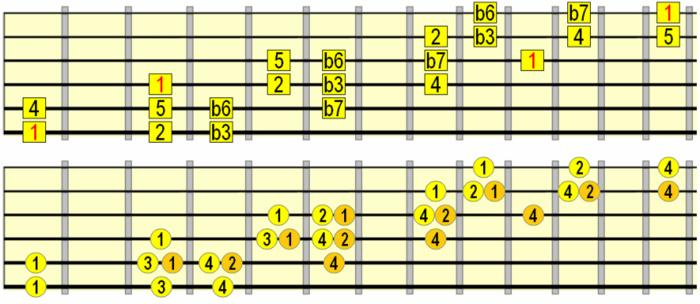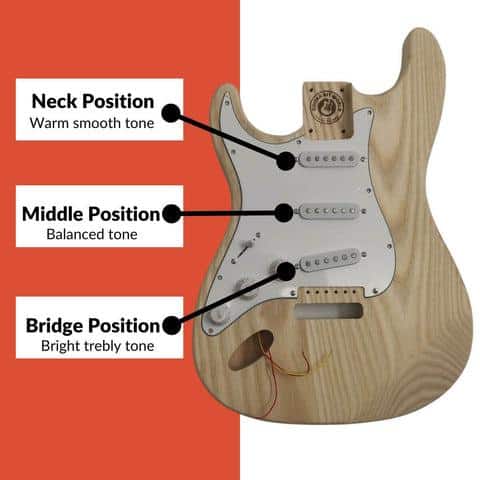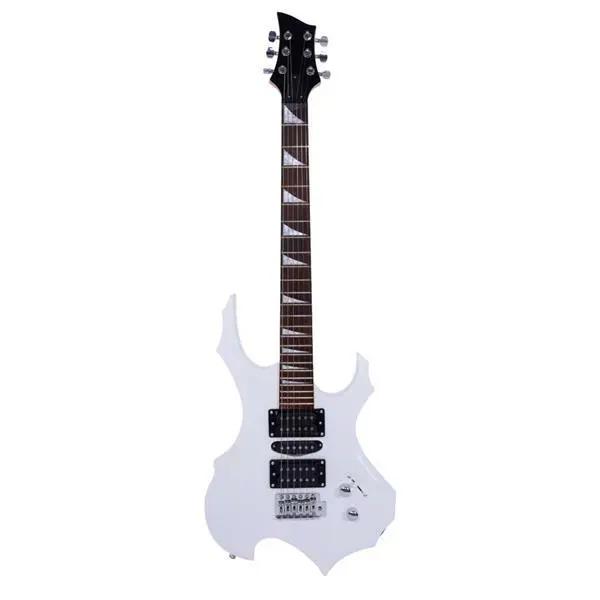Imagine striking a chord on your regular 22-fretted guitar then picking up a 24 fret electric guitar and playing the same chord. Could you discern the difference? As a Berklee College of Music graduate and seasoned guitar teacher, I’ve always been fascinated by this blazing yet subtle contrast.
Switching to a 24-fret guitar was a watershed moment in my musical journey and the intricate adventure that unfolded was nothing short of profound. But the mystery will prevail—hold on to that intrigue as we tread the path together. Sit tight, as this journey takes you to an illuminating destination—an understanding of the world of extra frets on guitar.
The transition was not a mere addition of two extra frets but a drastic shift in expression, leading to the exploration of uncharted tonal territories. Controversial yet intriguing, the 24-fret guitar might just redefine your perception of guitar capabilities.
Armed with my experiences and technical know-how, I invite you to plunge into this comprehensive guide. Together let’s dive into the unknown of the 24-fret guitar, meet the challenges head-on, tackle the myths, and sweep away the ambiguities. Ready? Let’s go.
Structural Differences: 24 Frets vs 22 Frets
Scalability and Fretboard Design

The relevance of scalability and fretboard design in a guitar, particularly when comparing a 24 fret to a 22 fret one, cannot be overstressed. As a teacher, I often emphasize the importance of understanding these factors. From personal experience, I can vouch for their effect on playability.
One of the key factors to grasp is scale length – the distance between the nut and the saddle. The scale length impacts the tension of the guitar strings, which in turn affects the playability and the guitar’s tone. 22-fret guitars generally have shorter scale lengths than 24-fret guitars, leading to a looser feel and warmer tone.
Another critical factor is fret size. Some guitarists prefer jumbo frets as they allow for easier bending and vibrato. However, it’s important to remember that fret size, along with scale length, affects string tension and thus, playability.
Undefined is the assumed similarity between the 22 and 24 fret guitars, which often leads guitarists to overlook the difference in scale length and fret size. Failing to comprehend these differences can lead to unsatisfactory performance and discomfort.
It would be remiss if I didn’t discuss the actual design of the guitar fretboard. Generally, 24-fret guitars have slightly longer fretboards to accommodate the additional frets. However, this extension doesn’t usually alter the position of the guitar’s pickups, a factor I’ll delve into in the following sections.
Understanding the subtle yet significant nuances between 22 vs 24 frets could make a world of difference in your comfort, playability, and overall guitar-playing experience. So, before making your next guitar purchase, take a moment to consider the implications of fretboard scalability and design. It’s a seemingly small factor that deserves attention for the immense value it adds.
Pickup Placement and Impact on Tone

As we navigate further into the crucial intricacies of a 24-fret guitar, let’s delve into an aspect I’ve found significantly impacts its tone – pickup placement. Throughout my music career, I’ve played numerous guitars with diverse pickup configurations and placements, enabling me to gather some fascinating insights.
Pickup placement is a key determinant in the character of the guitar’s output, directly influencing the neck pickup tone and overall sound. Coming from personal experience, moving the neck pickup closer to the bridge in a 24-fret model does alter the tone, making it a bit brighter and crisper compared to a 22-fret guitar.
This alteration can, however, be mitigated or enhanced based on the pickup configuration used. For instance, the widely used HSS configuration (Humbucker-Single-Single) can offer a classical rock tone on a 24-fret guitar. This tone, termed ‘undefined’ in our jargon, has an intriguing, uniquely modified depth that music enthusiasts find incredibly alluring – a magical blend of vintage and modern characteristics.
That’s a perfect example of how pickup placement contributes to the distinctive tone of a 24-fret guitar. A word to the wise here: don’t stop at mere experimentation with this. Understanding how different configurations and placements work will expand your musical vocabulary, opening doors to an unparalleled expression of yourself through your instrument.
With our focus shifting next to the impact on playability, remember, the journey of understanding your 24-fret guitar is like composing a beautiful piece of music – every note matters just as every piece of knowledge contributes to your overall mastery.
Impact on Playability

As we delve deeper into understanding the 24 fret guitar, it’s evident that two extra frets can mean more than just two additional notes. There’s a direct impact on playability, a term that essentially covers how comfortable and practical a guitar is to play. As an experienced guitarist, I’ve come to appreciate how vital playability is to achieving seamless notes transitions. Stick with me as we explore this.
The basic principle is this: the higher the number of frets, the longer the visible part of the guitar neck. While, in theory, the extended fingerboard should enhance note range, it can also make the guitar feel somewhat awkward. So you see, the equation isn’t as simple as it first appears.
Now, would your guitar play differently if it had two extra frets? Let’s find out.
When comparing a 22 fret guitar vs. a 24 fret guitar in terms of playability, one needs to consider the overall ergonomics of the instrument. A longer neck inherently changes the position of your fretting hand, especially as you reach for those upper frets. This is where those with smaller hands might encounter some difficulty. The further stretch required might affect technique or the speed of play.
However, it’s worth noting that extended range guitars, or ones that pack more than 24 frets, have been adopted by a variety of artists to broaden their musical vocabulary. These instruments demand a different playing style and technique, especially on higher notes. It’s a delicate balance that requires experience to handle.
The beauty of the guitar playability paradigm is that it’s immensely personalized. For some, the shift in hand position enhances comfort and navigability of scales. For others, it represents a hurdle – a barrier that restricts smooth play. Especially with 24-fret guitars where the frets are closer together, precision and finger placement become paramount.
Speaking from personal experiences, I initially found the 24-fret layout to be daunting. The change was subtle yet perceptible, a new terrain to traverse with my fingers. But as I spent hours exploring those extra notes’ aesthetic impact, I learned to appreciate the added dimensions to my sound.
One crucial advice I can offer is to not let the number of frets dictate your choice. Always consider what enhances your playability. Understanding how the added frets influence your playing style can make you a more versatile guitarist, widening your range and enriching your sound.
As we delve deeper into the tonal differences and musical genres, we’ll explore how these differences in playability ultimately translate to variations in sound.
Tonal Differences and Musical Genres

You may be wondering how tonal differences on a 24 fret guitar apply to various musical genres. After all, isn’t it the player’s interpretation and skill that ultimately determine the quality of the sound? To an extent, yes, but guitar tonality plays a significant role that cannot be overstated. As someone with a background as a music critic, coupled with ample playing experiences, I have a unique perspective on this subject. Let’s tune in and explore this further.
In my many encounters with the guitar, exploring multiple genres, it has always struck me how the character of the instrument changes with different musical styles. From using a vintage guitar for jazz to a modern shred guitar, the tonal possibilities are endless. The extra range provided by a 24-fret guitar truly stands out when different playing techniques across genres are utilized.
Now, you may ask: Do you think all genres of music can be played suitably on a 24-fret guitar? The answer might surprise you. Theoretically, yes. One could argue that the guitar’s tonal palette is broad enough to accommodate every genre. However, the suitability of a 24-fret guitar often lies in the demands of the specific musical style.
When we discuss shred guitar players, their choice of a 24-fret guitar isn’t a mere preference, but a necessity. The ability to reach those extra high notes can elevate a solo performance, offering a level of intense high-frequency sound that a 22-fret guitar just can’t match. Contrast this with guitar for jazz, where players often yearn for a warm, mid-range tonality. Here, a vintage guitar might be more suitable. However, the 24-fret guitar can open up new tonal possibilities within the genre by providing access to previously unplayable higher-register melodies.
A crucial aspect to remember about tonal qualities is that they are not solely determined by the number of frets. Pickup placement, string gauge, and the guitar’s structural elements all play decisive roles in shaping the sound. Even the minor difference between modern vs vintage guitars can impact tonality. Thus, an understanding of tonal differences as per musical genres is essential for any guitarist, whether your preference is jazz, rock, or any other style.
Closing my thoughts on this, the most important thing is not to get too caught up in the debate between different guitars and their tonality. Instead, focus on the style you are playing and whether your guitar supports your creative expression within that genre. Remember, the real magic lies in the individuality of your playing, along with how effectively you manage to use the tonal range of your instrument to convey the soul and spirit of your music.
Popular 24 Fret Guitar Models

Time and again, I have found myself drawn to these high-performance 24-fret models, marvelling at the unique craftsmanship that each brings to the table. Of all the guitar models I have played over the years, there are a few that truly stand out for their combination of playability, construction and tone qualities. These are the ones that have left a lasting impression – not just on me, but on countless other musicians as well. And the more familiar you grow with these models, the easier it becomes to understand their enduring charm.
Ever wondered what makes some 24-fret guitar models stand out among others? Captivating in their individual allure, a few models beg immediate attention. Let’s discuss these popular choices.
Among the many quality 24-fret guitars I’ve wielded, the PRS Custom 24 always stands out. Its elegant sculpted figure not only looks beautiful but it’s one of the most comfortable guitars I’ve ever played. The wide-thin neck design provides a great feel, allowing for fast playing styles. The tone, thanks to the pair of custom-voiced humbuckers, is both warm and versatile, contributing to its widespread appeal across various genres.
On the other end of the spectrum is the Gibson SG Modern, a beast of an instrument that perfectly combines contemporary features with Gibson’s legendary craftsmanship. Known for its sustain and pronounced midrange, the Gibson SG has been a staple in rock and roll history. The modern version, with its two humbuckers and a fast-access neck, provides incredible playability, all while maintaining that iconic SG tone.
The Ibanez AZ series, on the other hand, have quickly become favorites among the progressive metal crowd. Often described as a “player’s guitar”, the Ibanez AZ series guitars, with their Hyperion pickups and superior switching system, deliver a wide gamut of tonal options that can cater to any kind of musical style.
Finally, for those who prefer the classical style, the 24-fret model from Takamine is a worthy contender. Known for their fusion of traditional and modern design concepts, Takamine’s 24-fret classical guitar exudes the charm and resonance of old times, combined with a touch of modern functionality. It truly represents a beautiful marriage between the old and the new, the raw and the refined.
The beauty of these 24-fret models isn’t just in their innate qualities, but also in how their distinct personalities bring something fresh and exciting to the table each time you pick them up. From the searing leads of the PRS Custom 24 and the Gibson SG Modern, to the tonal mastery of the Ibanez AZ series and the Takamine’s classical charm – I trust you’ll find a model that perfectly resonates with your own musical aspirations. Ultimately, your choice of a 24-fret guitar will heavily depend on your personal preference, playing style, and musical genre.
Understanding Guitar Specs and Intonation

As we move forward in our journey of understanding the 24 fret guitar, I find it imperative to pause for a moment and revert to the very core—the specifications of the guitar. This brings us to an interesting question. How much of a role do the guitar’s specifications play when considering intonation? More than you might think.
I have been nurturing new talents throughout my career, and an element I often stress to my students is how crucial understanding a guitar’s specifications is for mastering intonation. Let’s delve into this.
Guitar specs, in essence, encompass a variety of elements that collectively contribute towards the sound and playability of the instrument. One integral component here is the string tension. Greater tension leads to a sharper pitch, while reduced tension results in a flatter pitch. A small adjustment in the tension can significantly influence the guitar’s intonation. The art lies in finding a balance where the tension is just right, and the notes play clear and true. This intricate dance might be challenging for beginners, but I assure you, with adequate practice and understanding, it can be seamlessly mastered.
I can’t stress enough on the importance of the correlation between guitar specs and intonation. A guitar may have stunning aesthetics but with inadequate intonation, it will fail to perform up to its potential—similar to a sports car with incorrect wheel alignment.
On many occasions, I have seen my students getting frustrated and attributing their struggles with intonation to lack of skills. However, it was usually the overlooked mismatches in guitar specs causing the discrepancies. Understanding the underrated significance of guitar specifications, therefore, is not just essential, it’s transformational.
Another key aspect that falls under guitar specs is the action— the distance between the strings and the fretboard. Lower action might make the guitar easier to play, but it can cause buzzing notes, which in turn affects the intonation. Conversely, if the action is too high, the strings are harder to press down, which can inadvertently cause string bending thus distorting the intonation.
If you’ve read through this far, you should now have an understanding of the sheer impact of guitar specs on a guitar’s intonation. In our exploration of the 24 fret guitar, appreciating these subtle aspects will equip you with the eye to evaluate a guitar not just based on its number of frets, but rather its overall build and intonation potential.
As we proceed, we will navigate deeper waters of the 24 fret guitar’s intricacies and their implications on a player’s style, tone, and choice of genre. Indeed, understanding guitar specs and intonation is not the end but rather a significant waypoint on our quest. There is so much more to uncover, and I am excited to share the journey with you.
FAQs
What makes a 24-fret guitar different from other guitars?
How to adapt your playing style for a 24-fret guitar?
What is the benefit of having 24 frets on a guitar?
Conclusion
In essence, the real beauty of 24 fret electric guitars lies not just in the enlarged melodic possibilities but in the enhanced guitar playability it offers. Understanding the distinctive structural features, from scalability to pickup placement, is key to appreciating this instrument’s unique tonal qualities and the diverse musical genres it suits. But remember, the true power of these guitars unfolds in the hands of a passionate and informed player.
This brings me back to my initial suggestion – “The matrix to unlock the true potential of a 24 fret guitar lies within your commitment to truly understanding it”. The intricate blend of technical and creative aspects shape the music we deeply love. And even more importantly, the full scope of a 24 fret guitar’s capabilities isn’t a one-size-fits-all conclusion but a continuous journey of exploration and discovery.
Lastly, my personal journey with guitars has taught me that the more you uncover its intricacies, the more intimate your connection becomes. So, here’s to a rewarding journey of molding beautiful music with your 24 fret guitar. Remember, in-depth understanding fosters undiluted passion – so immerse, master, and create!
